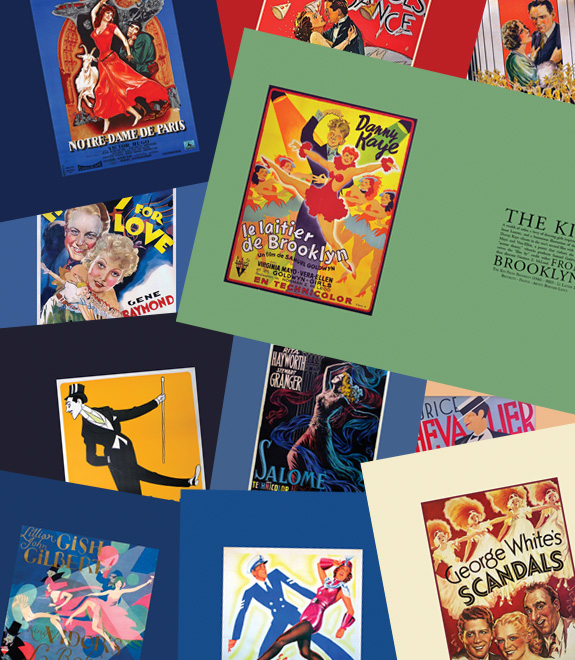Foreword
For fans of cinematic dance around the world and particularly for those who, like myself, breathe the movie-tinged air of Los Angeles (where it all happened), Mike Kaplan’s gorgeous, color-drenched movie posters – each a paean to the art of dance for the camera – bring unfettered joy. Kaplan’s distinguished and lovingly constructed collection, one hundred gems of Hollywood history, range from splendid one-sheets to miraculous oversized European posters. Having toured the Roy Furman Gallery at Lincoln Center, California Heritage Museum in Santa Monica and William Rolland Gallery of Fine Art at California Lutheran University, the collection’s most recent honor is its showcase, the entire summer 2014, at Jacob’s Pillow, the nation’s historic dance festival in the Berkshire Mountains. This exhibit unambiguously signals the “establishment” dance world’s unalloyed embrace of its vivacious (and thanks to movie magic, eternal) little sister known as Hollywood dance.
Indeed none of the dance numbers memorialized in Kaplan’s heady collection – so alluring, so magical, even in their frozen poses so visceral and alive – stem from live stage performance. Instead they came into existence at often ungodly hours of the day, performed before distracted if not totally indifferent audiences of cameramen, script girls, gaffers, sound guys, and make-up ladies. The sequences were shot not on Broadway nor at Lincoln Center, but in hanger-style soundstages of Culver City, Hollywood and Burbank.
Each vibrant rectangle, packed with aesthetic information, celebrates not only the creative crew who fabricated movie-musicals: the choreographers, performers, and production people who cranked them. As a film-marketing guru himself, Kaplan also treasures the febrile minds tasked with their promotion.
Kaplan, a passionate advocate for posters as an art form, unites dance and film fans across borders. For the collection’s great genius is its internationalism. The posters reflect how ‘Made in USA’ celluloid fantasies were repackaged for global markets. Kaplan’s beloved artists – Frenchmen Roger Soubie, Bernard Lancy and Boris Grinsson, the Italians, Ballester and Nano, Germans Meinss and Hubner, the Argentinean Tomey, and Sweden’s Rohman, Moje Aslund and Gosta Aberg – captured their subjects from afar: Rita Hayworth, Fred Astaire, Ginger Rogers, Gene Kelly, Cyd Charisse and Marge and Gower Champion, the top-ranking gods and goddesses of moving pictures. Hoofers and high-flyers James Cagney, George Chakiris, Dan Daily, Betty Grable, Ann Miller, Gene Nelson, Donald O’Connor, Eleanor Powell, Jane Powell, Debbie Reynolds, Vera-Ellen, and The Nicholas Brothers also show up, locked in perpetual motion, in ecstatic freeze-frames.
Beyond the main objective – to allure and advertise by imprint of image – for this dance writer, added pleasure comes from the posters’ rarefied use of text. I love how words interact with graphic elements. The wild parade of fonts! The romantic foreign-language titles! The often wacky hierarchy of credits: whose name gets featured, whose diminished. Everything in the condensed canvas matters. And courtesy of Mike Kaplan’s savvy eye and his connoisseur choices, movie propaganda never reached more dazzling heights.
Debra Levine, a dance critic for the Los Angeles Times and
The Huffington Post, blogs on dance & film on arts∙meme.

